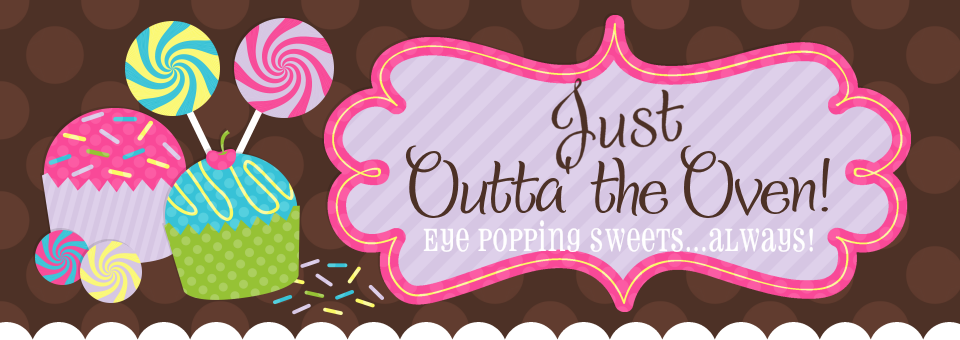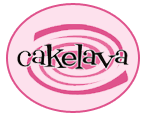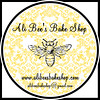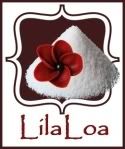There’s nothing like the “wow” factor of an artfully presented cake. Purse cakes hit the cake scene a few years back and show no signs of slowing down. I’ve given classes on this simple purse cake style to beginners for the last year and a half and decided to share this tutorial with the bloggy world.
When I began planning this lesson a while back, I approached it as if I were a beginner baker and decorator. I didn’t want to make such a large cake that would require additional structural support like dowels. A small cake that easily yielded 6-10 servings was in order. Usually a beginner will be baking a cake for immediate family or close friends not for a crowd of 20 or 30.
Most newbies will not make a cake from scratch. So out came the cake box mix, canned frosting (eww) and your typical non stick 8” round cake pans. It certainly helped with troubleshooting and “trouble” was certainly the operative word here. Talk about spazzing out. It’s no wonder folks give up on going that extra mile to create something special.
It’s very difficult to shape a cake with a box mix. Way too spongy and soft for carving; even after I froze the layers. Forget about canned frosting, it’s designed to be smooth and creamy and never sets up firm enough to withstand carving. And that’s before you tackle icing with fondant. Please.
Dark non stick baking pans are a nightmare. It’s very easy to over bake, shrink and dry out your cakes when using non stick, especially in convection ovens. When you think about it, these types of pans are unnecessary when you can easily use cooking spray oil with flour in it already. That, with a piece of parchment in a regular baking pan, almost guarantees you can pop those babies out perfect every time.
So back to the drawing board I went, rolled up my sleeve and started fresh. First things first, I started with a 1-2-3-4 cake recipe baked from scratch, made a batch of my favorite Swiss meringue buttercream and used 8” aluminum baking pans. That’s it. This is all it takes to make a tasty and memorable cake and one that can stand up to sculpting!
On average, it takes about an additional 15 minutes to make a cake from scratch than from a box, so go the distance. Think beyond the box mix, the results are dizzingly delicious and infinitely better. Feel free to roll your eyes, I can’t see you anyway.
Once your cakes are baked and cooled to room temperature, wrap tightly in plastic wrap and freeze or refrigerate for 5-8 hours or overnight. Cakes should be very firm to begin carving, shaping and sculpting. This is a good rule of thumb for ANY kind of sculpted cake.
As for filling and icing, any buttercream recipe that contains well, butter, not shortening, will set up firmly and be sturdy enough to sculpt with once you’ve chilled your iced cake. Now is not the time to add fresh fruit , whipped cream or pudding as a filling to a cake that will be shaped into, oh I don’t know, let’s say a toilet bowl.
Remember…sculpted cakes need structure not fluff.
Now we’re off to a seriously good start. Get a ruler and an exacto knife or scissors. Measure and cut a cake board or foam core board into a piece that measures 3 in. x 8 in. Set aside.
Next, using the same ruler and a long serrated knife, measure and cut your cake layers into the same dimension as your cake board. Save the “half moon” shaped scraps, you’ll need them.
Attach one layer of cake on the board with a dab of buttercream and begin to fill bottom layer of cake with buttercream filling.
Add the next layer of cake and top with buttercream once again.
Take the two left over scrap pieces of cake and place on top of the second layer of buttercream.
Here’s where the fun begins, sculpting! I got the idea for the shape from one of my daughter’s “fashion” purses and I say that loosely.
With a smaller serrated knife (think steak knife) simply follow the curvature of the half moon layer and gently cut down at a slanted angle. I can do this by eyeballing the cake, however, you may want to make a little template from construction paper, slap it against the cake and carve from there. Cut the other side of the cake and you should have two sloped sides that mimics the sides of a pyramid. Following me?
Begin to carve the top of the cake into a concave shape. Once you’re done, the top of the cake should look like the bottom of a bowl. Did I lose you? Just look at the photos!
At this point you can tweak the shape of your cake by gently carving and sculpting tiny piece by piece if you wish. Also, trim away any excess cake board to fit the new shape of the cake.
Crumb coat your entire cake, including the cake board, with a thin layer of buttercream to seal in any pesky crumbs and place in the fridge for about 10-20 minutes to set the icing before adding your fondant.
Fondant is fun to use for sculpted cakes. It may not be everybody’s favorite icing but you can achieve a better looking finished cake than you would with just icing. Make sure your area is clear of any renegade cake pieces, crumbs and just general clutter.
Roll out the fondant just as you would cookie dough. Turn the fondant around a few times while you’re rolling to avoid sticking and ensure even thickness. I roll fondant to about ¼ inch thick, roll it gently onto a rolling pin then carefully unroll it over the cake.
Starting on top of the cake, quickly but gently smooth the surface of the cake with the fondant on all four sides. Being heavy handed will NOT help you at this point in the game. Pop any air bubbles that develops with a pin prick.
When the cake and cake board is entirely covered with fondant and smoothed out, cut away any excess fondant at the base of the cake with a pizza cutter, paring knife or exacto knife leaving a straight edge.
In front of you lies a blank canvas ready to be decorated any way you wish!
I opted for purple luster dust applied with grain alcohol and a paint brush in a checkerboard pattern because at the time I was preparing for a spring class.
Once I was done painting, I made the “flap” of the purse by rolling and cutting out a sage green piece of fondant using a 6” cake board as a template. I then strategically placed it on top of the cake.
I then “glued” the cake with royal icing on another cake board covered with decorative aluminum foil. Using royal icing, I outlined the edges and bottom of the cake and used it to glue fondant daisies I had cut out with cookie cutters.
As for the handle of the purse, I opted for wired ribbon. Why? Well, I didn’t want to overwhelm the beginner with another medium, like gum paste, which has to be shaped, preferably with a mold and dried out for a few days to a week before placing on the cake. A pretty, textured ribbon can add extra color and whimsy to your finished cake just as easily and quickly.
The idea is to make a sweet little cake for your little girl or granddaughter or just for fun for a girls’ night out without having a nervous breakdown=D.
So there you have it! I hope my written instructions are somewhat clear. I have the gift of the gab and it’s a lot easier for me to verbally instruct and answer questions as they come up in class. Let me know what you think and if you have any additional ‘pearls of wisdom’ please share them! =)
Happy Baking!




























10 comments:
uhhhh I want to be able to make such incredible fondant creations, but I guess I have commitment issues. It always starts out great but then 1/2 way into the process I'm done and want nothing more to do with fondant or cake. I think I need to start with a cupcake or a cookie and then work up. Starting with a gothic style cathedral is probably not a good idea. :) I'll be using this tutorial and any others you have to offer often.
HeeHee! Gothic style cathedral is probably not a good idea for anybody to start with unless you have your own cake show and have your minions doing all the work for you=D So glad my tutorial will be of use to you! If you break it down you only need three "cuts" to shape this style purse. Have fun and have a few cocktails ready!
Good, easy to follow tutorial. Glad you went with a scratch cake.
Your tutorial makes me think that even I could produce a cake like this one day.
Thanks Paula! That's exactly what I want you to believe! And thanks for telling me the tutorial is easy to follow. This writing thing is a little tougher than I first thought=D Give it a go one day=)
What a great tutorial for such a beautiful cake! I have done some cake decorating but don't have much experience sculpting cakes. Thanks for posting such great step-by-step instructions and pictures.
What great instructions!!! I would love to try this! Will you be sharing any trusted cake recipes?
(hoping with fingers crossed...)
Thanks Lizy! Looks like I failed to link the recipe I used with my post=( Such a newbie=D Will be re-posting soon, keep an eye out=)
Hi Myrna,
I came across your blog when I was just googling idly for pretty cakes and i must say, it is awesome. Your tutorial is very easy to understand and you make it look easy. So I am very tempted to give it a try though most of my cake baking attempts have been disasters so far. We do not have many cake baking classes in India so I have to rely on the internet for my adventures. I will try this tomorrow :). Right now, I am fwding your blog link to all my friends who love cookin n baking. I am sure they'll love me for this :)
Poornima
Well hello there Poornima! Welcome and thank you for visiting! India, wow! I'm happy to know you'll be using my tutorial on your cake ventures! When I started I heavily relied on cake decorating books, just "winging it" and thru trail and error=D Enjoy the process and I hope to hear good news from you!
How could I make this a chocolate cake?
Post a Comment